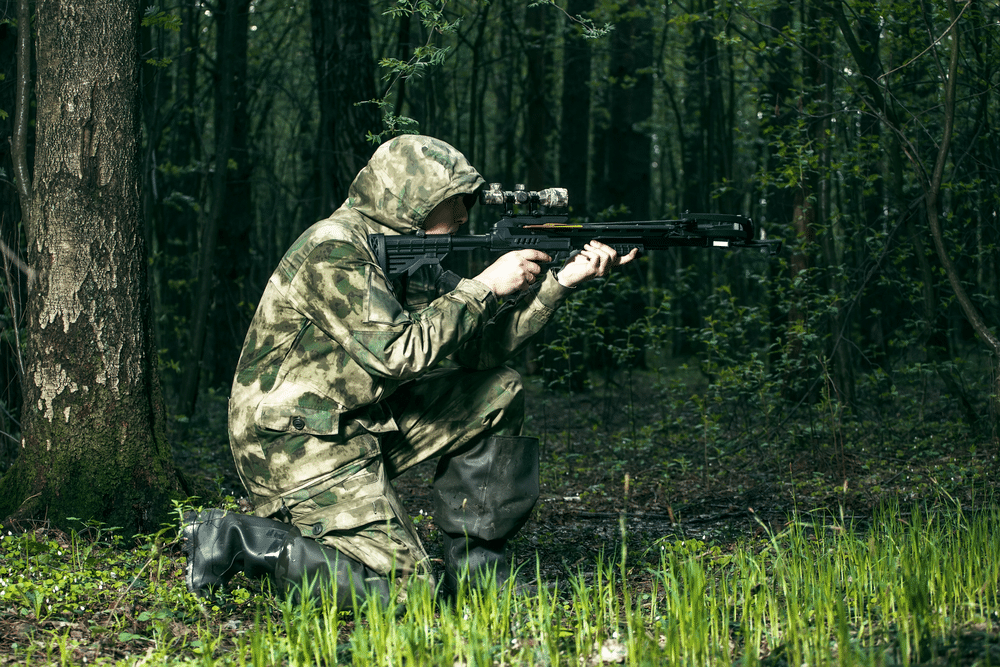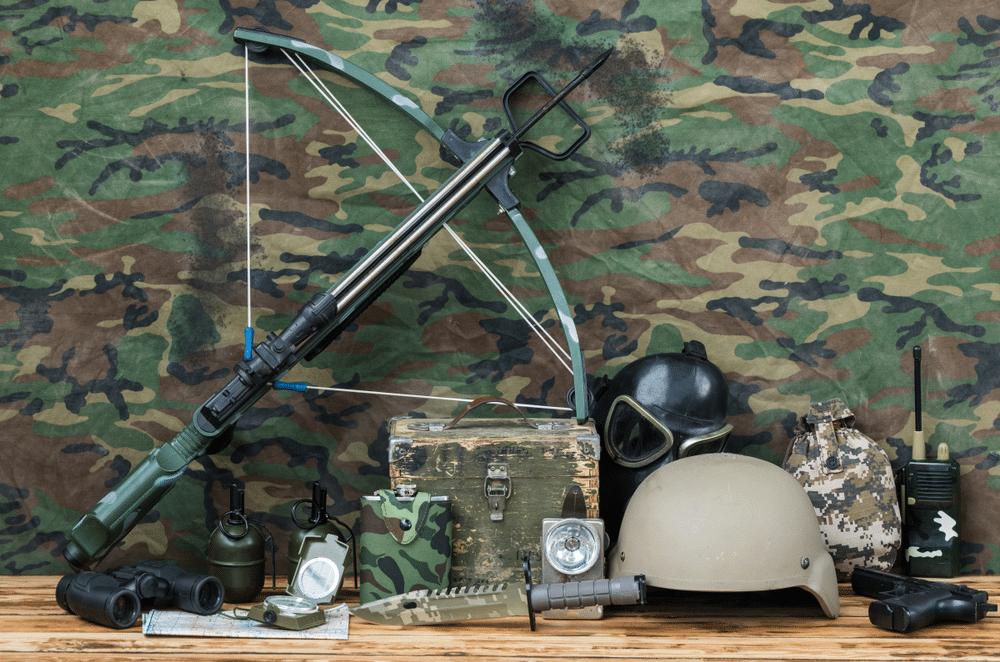Crossbows are a unique tool. They are somewhat like a gun, somewhat like a bow, and need to be thought of as both when it comes to safety. There are also some additional considerations needed to make sure your use of this superb hunting implement is safe and enjoyable.
Firstly, remember treat a crossbow as if it were a firearm and use the four fundamentals of safety we have all been taught to use with a gun.

20 Important Crossbow Safety Tips
Find below the 20 most important tips that you need to know if you’re using (or planning to use) a crossbow for target shooting or hunting.
1. Always assume your bow is loaded and ready to fire
Treat the bow as if it were cocked with an arrow in place. If you hunt, you have seen the damage a crossbow bolt can do. Make sure it only does it to an appropriate target.
2. Never point the bow at anything you are not willing to destroy
Be cautious of where the action end of the crossbow is and never point or sweep it across any living thing that is not your target. Keep the muzzle pointed away from property you don’t want to be damaged.
3. Keep your finger off the trigger until you are ready to fire
Only place your finger on the trigger as the last step before firing. You should have checked your arrow is in place, the target is in your sights, the safety is disengaged, and everything is ready before you even think of pulling the trigger. Disengaging the safety should be the very last step before your finger touches the trigger.
4. Be sure of your target and what is behind it
Make sure the target you are shooting at is actually what you think it is. Raise your head off the sights or scope and look closely. Only when you are positive of your intended target should you prepare to take your shot.
Not only should you be familiar with gun safety but you should also treat your crossbow as if it were a bow and practice the appropriate safety steps you would with any bow.
5. Check your equipment before drawing your crossbow
Make sure all strings and pulleys are sound and properly strung with no frayed cords or strings and no chipped or cracked pulleys. If you are using a recurve style crossbow, make sure the string is sitting fully in the nocking points. Ensure your limbs and bow frame are free of cracks and defects that could cause them to break. Check your arrow rest is free of debris and the arrow lays in the grove as it should. Double check any accessories or attachments to make sure they are secured. Make sure arrows are solid with no defects before loading them. Some arrows can explode under the force of the string if they are cracked or damaged.
6. Never dry fire your crossbow
A single dry fire (firing the bow without an arrow) can cause catastrophic damage to your bow, making it unsound to ever shoot again. If you do accidentally dry fire, you will need to get your bow checked by a professional before using the bow. Never attempt to draw a dry fired bow that has not been inspected.
7. Select the appropriate arrow for your crossbow
Make sure the arrow you use is a length that extends to the end of the track. Most bows have some sort of ring or guard that the arrow passes through. No arrow that does not extend beyond that guard should be used. Arrows should also have a stiffness appropriate to the power of your crossbow. Check with a professional to see what arrows are suitable. Shooting arrows too light will have the same effect as dry firing your bow.
8. Always perform basic maintenance
Though this goes very much along the lines of checking your equipment, it is vital to understand and conduct proper maintenance on your bow after every use and before taking it into the field. Keep moving parts lubed and strings waxed. Replace parts that are showing wear, especially strings.
9. Keep broadhead arrows in a protective quiver or case when not in use
Broadheads are often honed and will cut with little or no pressure. Keep them in a good quality quiver that holds the arrows securely. You may also elect to keep your broadheads uninstalled and in a case until you are in your hunting position. Accidental cuts are the number one injury during bow season.
10. If you are target shooting, always check your backstop
Make sure your backstop is in good condition and capable of stopping a full force arrow from your most powerful bow or crossbow. Even after glancing, an arrow is capable of traveling large distances with plenty of power to cause injury or damage.
Because of their unique form and function, there are some safety measures that apply specifically to crossbows. Very few people go straight to a crossbow without learning basic bow and firearm safety. Regardless of experience with other hunting tools, those new to a crossbow should be very vigilant in dealing with the unique characteristics of this tool.

11. Properly load your crossbow
Before placing an arrow in the crossbow, make sure that the bow is fully cocked and the string sits in the bottom of the string groove. Place the bow on safe if it does not automatically do so. If your bow automatically engages the safety, double check it. Before you fire your bow, check the arrow and string placement again making sure that the string is seated properly and the arrow is firmly against the arrow stop.
12. De-Cocking a Crossbow
There is no safe way to de-cock a crossbow by hand or any cocking device and trying to do so can cause damage to the bow. The safest way to de-cock a crossbow is to fire it at a safe target. Some companies sell special arrows for this purpose so you don’t damage an expensive hunting arrow.
13. Make sure hands and other obstructions are not in the string path
Even a light crossbow can break a finger if it gets in the way of the string. Some modern crossbows have enough power to amputate appendages. Practice safe hand placement, this is especially important if you are shooting from a supported position as your grip may change. Foreign objects in the path of the string can be propelled with great force and may cause injury or damage to the bow.
14. Do not fire a crossbow with people standing beside you
Should you have a failure of the string or pulleys, most of the force and debris will be scattered forcefully sideways and could strike those near you. Keep other shooters and spectators a few steps behind the shooting line if you are at the target range. Also, avoid heavily obstructed shooting areas that may cause broken pieces to rebound back at you.
15. Do not store your crossbow cocked or loaded
Prolonged stress on the limbs, cables, or pulleys may cause damage that cannot be seen until the bow is fired. Always de-cock your crossbow safely before storage.
16. Do not shoot anything out of a crossbow that the bow was not designed for
This may seem obvious but people have been injured attempting to shoot broom handles, speargun spears, golf balls and a variety of other items from their bow. Not only can these items damage the bow but they are unpredictable and could fly almost anywhere causing damage or injury.
17. Treat your crossbow like a rifle
Don’t carry a bow by the stirrup, limbs, string, or cocking mechanism. Carry the bow as if it were a rifle but never over your shoulder. Only fire the crossbow from a solid hold, where it is fully seated against your shoulder, this is especially true with modern reverse draw style bows.
While the above tips will go a long way to keeping you safe when using your crossbow, there are some hunting specific tips that may not always be crossbow specific but are worth keeping in mind to ensure your excursions are as safe as possible.
18. Do not climb a tree stand with a crossbow, especially a loaded one
Instead, use a bow rope to pull your bow up once you are in place. Keep the bow pointed downward and never put an arrow in the bow until you have it in your hands.
19. Cock your crossbow before you climb
Don’t attempt to cock a crossbow in a tree stand, it’s a sure way of slipping off the small area available. Cock the bow on the ground but never place an arrow in the bow.
20. Use a harness and safety line in tree stands
Never occupy a stand without a fall prevention system like a rope and harness. In the heat of the moment, accidents happen and falling from a tree is a great way to cut your hunting short and end up with a trip to the hospital.
Hunting with a crossbow, where legal to do so, is a very rewarding hobby. Crossbows are much easier to shoot accurately than a standard bow and generally enjoy the same season in most states. Keep your head about you and use some common sense and you should be able to come away unscathed. Several thousand people are wounded every year in the U.S. due to hunting accidents. More than a hundred die. Don’t be a statistic, read your manual for more on best practices in a crossbow use.
If you are still unsure about any function of your crossbow or about any of its features, visit a local hunting store or archery outlet, most will have someone who will be more than willing to offer you the guidance you need and provide hands on safety demonstrations.
More useful archery blog articles
Enjoying archery or hunting? Take a look at some of the most popular blog articles below. Oh, and don’t forget to subscribe to our newsletter to never miss on the next guides and the best deals!
did you enjoy this article?
We hope you enjoyed reading this blog article and that you found it useful. If you have any suggestions or comments, do not hesitate to get in touch.
If you liked this blog article, why not share it on your social media to let your friends and fellow archers know!

